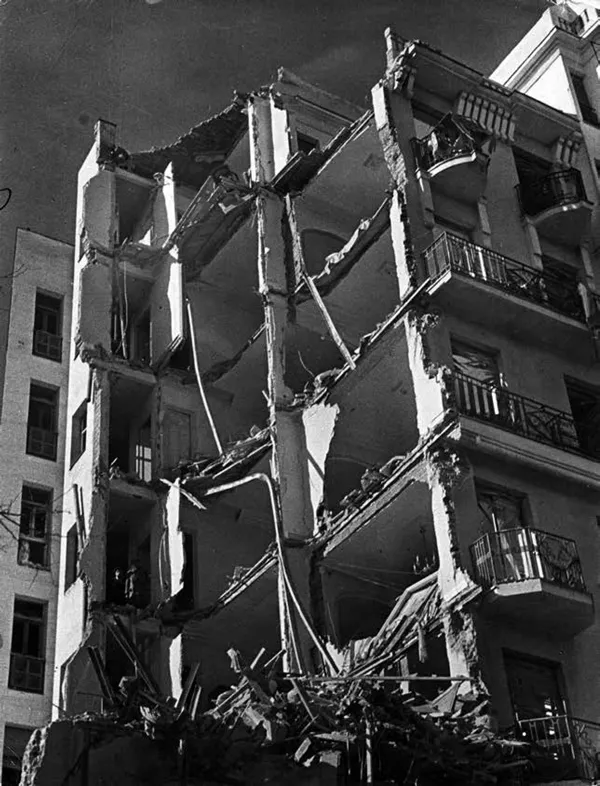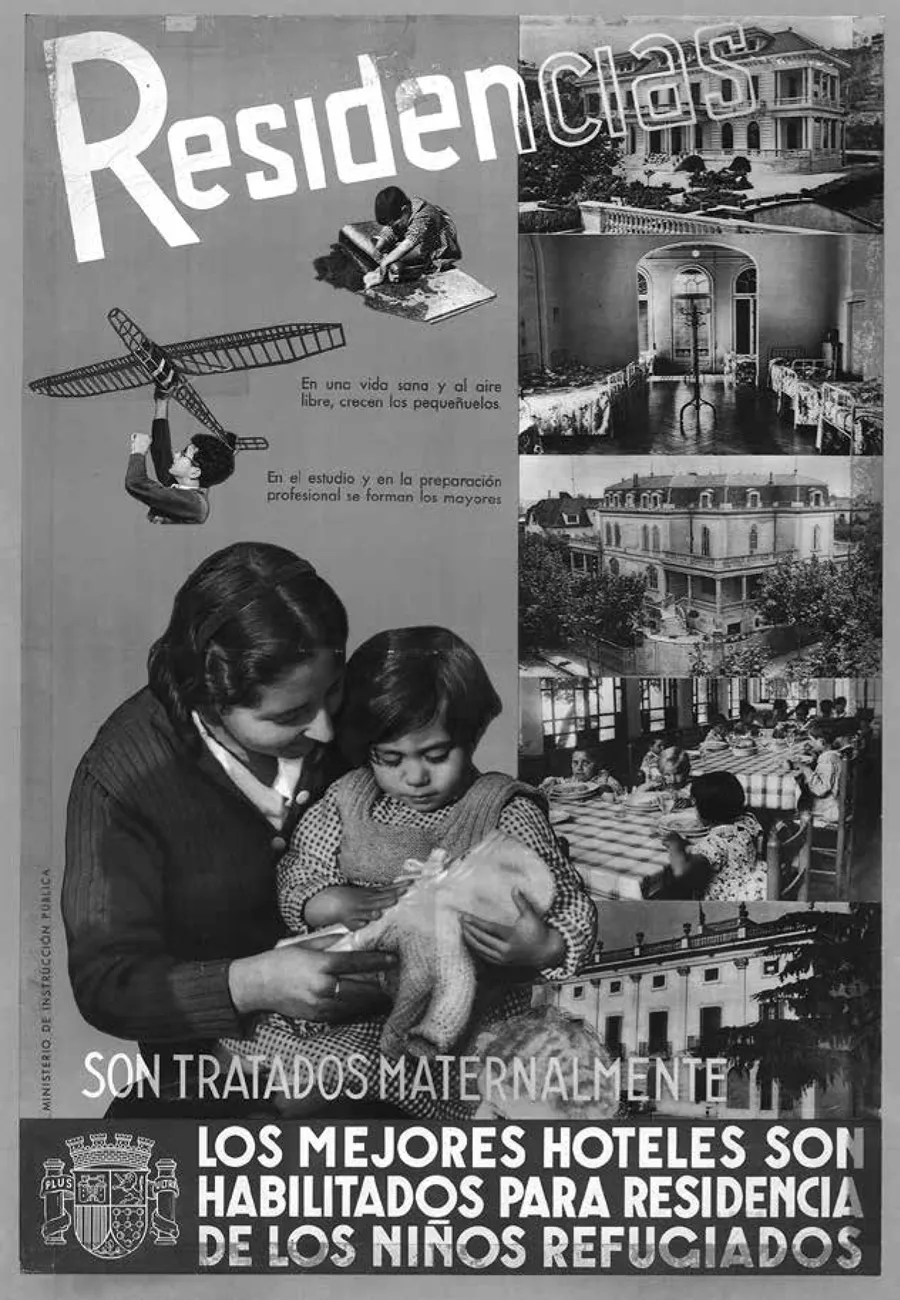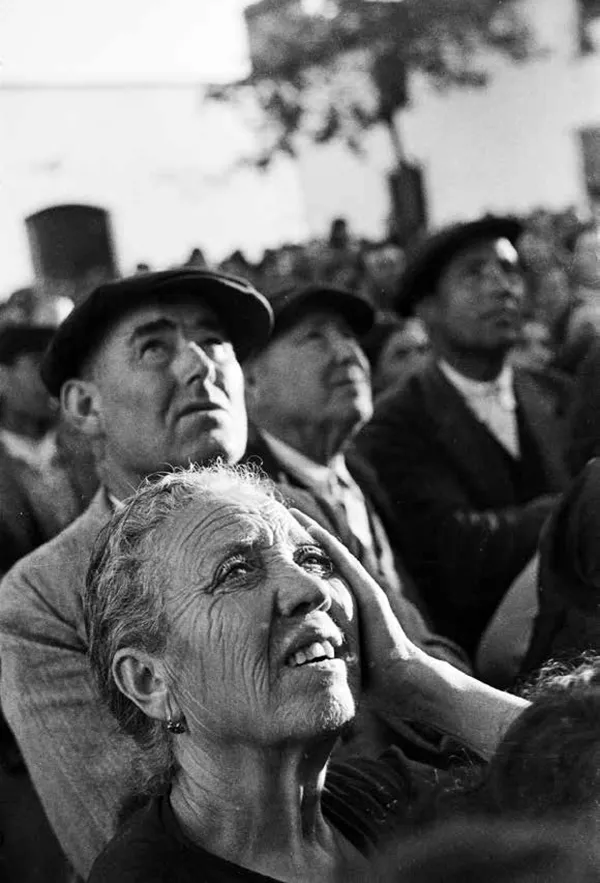![]()
PART 1
MEMORY AND THE VISUAL ARCHIVE
![]()
1
Memory as Montage
Spanish Civil War Photography
Scissors and Truth
The man at the table—sweater vest, checkered shirt, glasses—is working on a large panel on which we can distinguish images of women and children. Behind him, a finished panel of the same size shows a photograph of a bombed-out apartment building that almost covers the board’s entire surface. The building’s façade is gone entirely; we can see straight into living rooms. Superimposed on the bottom left corner are two images of a crowd looking up at the sky, with an old woman’s face centrally in focus, her left hand on her cheek and temple in an expression of concern. A Dutch text, placed at a slight diagonal at the top of the panel, reads: “Pilots did their job.”1 The scene takes place in what looks like a studio. Behind the man in sweater vest are half a dozen others, working on more panels at a large drawing table. The atmosphere seems animated and optimistic.
We are somewhere in Amsterdam, the Netherlands, in late 1937 or early 1938. The person in the forefront is Peter Alma (1886–1969), a Dutch painter and graphic artist in his early fifties who had joined the Communist Party in 1919 and was active in various solidarity movements throughout the 1920s and 1930s.2 The group is busy preparing an exhibit, “The Truth about Spain,” consisting of thirty large mounted panels. It opened near the Amsterdam harbor on February 1, 1938, and traveled the country after that. The show was an initiative of the artists’ union on behalf of the Committee to Aid Spain (Commissie Hulp aan Spanje), the Dutch subsidiary of the World Committee against War and Fascism coordinated from Paris by Willi Münzenberg, the Communist International’s publicity czar (Flinterman 1985, 15–17). The Dutch exhibit was one of many such projects undertaken across the world by activists, intellectuals, and artists concerned with the fate of the Second Spanish Republic. In July 1936, Spain’s legally elected government—a Popular-Front coalition that had been voted into office in February—had withstood a right-wing military takeover. But it was now engaged in a bloody armed struggle with the military rebels, who called themselves Nationalists. The conflict was much more than just a civil war, and for three years all the world’s eyes were on Spain.3 Nazi Germany and Fascist Italy supported the rebels, and the Soviet Union sold arms to the Republic, while all other major Western powers opted for neutrality or non-intervention. Still, concern about the events in Spain prompted massive mobilizations of civil society in Europe and the Americas. Thousands of people in scores of countries invested their time, energy, and talent to raise funds and public awareness about the dangers of fascism and the folly of nonintervention. They faced resistance from groups sympathizing with the Nationalists, who were led by the young general Francisco Franco Bahamonde and had the worldwide support of the Catholic Church. From San Francisco to Shanghai and Paris to Portsmouth, the Spanish Civil War divided public opinion everywhere.
The photograph of the bombed-out building on the panel behind Alma was by Robert Capa, a twenty-four-year-old Hungarian refugee who was just starting his career as a photojournalist (fig. 1.2). He had shot it in Madrid in late 1936, as part of a story documenting the material and human devastation wrought by the Nationalist bombing campaigns that targeted the civilian population in the major cities held by the Republic (Lahuerta 2010, 172).4 The pictures of the crowd were by his good friend David “Chim” Seymour, who was born in Poland. These photographs actually predated the military coup that had unleashed the war in Spain: Chim had taken them in April 1936 at a land reform meeting in a small town in the south-western region of Extremadura. The contact sheet of Chim’s negatives, which were miraculously recovered in Mexico City in 2007, makes clear that the crowd is not looking up at bomber planes—despite the apparent expression of concern—but at a speaker on the balcony of the city hall (C. Young 2010b: 16).5 The panel on the table that Alma is working on, meanwhile, is clearly inspired by a Republican propaganda poster, Residencias, which publicized the government’s efforts to keep the country’s children safe from the war (fig. 1.3). (Alma used the same design concept, although he dropped one of the poster’s five photographs and added two other elements: a picture by Capa of a mother and child and a drawing from yet another poster.6) Children’s safety was a prime concern in wartime Spain. From the beginning of the fighting, civilians were targeted on an unprecedented scale—not only with city bombings but also by extralegal executions, torture, sexual violence, and forcible displacement (Preston 2012).
As it happened, it wasn’t the first time the woman’s portrait by Chim had been on show in Amsterdam. Half a year earlier, in June 1937, it had been part of a legendary photography display at the Stedelijk Museum organized for the artists’ union by the Hungarian photographer Eva Besnyö. The exhibit’s title, “Foto ’37,” indicated the organizers’ intention to showcase the medium’s state of the art. The 1,500-piece show included all types of photographic work ranging from x-rays, color photos, and cartography to advertising, montage, and photojournalism, while one room was dedicated to the history of photography, starting with Daguerreotypes, and another section featured kitsch photography (Bool 1979, 127; Visser 2009, 60–63). The show was a smashing success, drew more than four thousand visitors, and was extended until the end of September.
The same crop of Chim’s Extremadura scene appears in the modest catalog (fig. 1.4), which came out as a special issue of the union’s magazine (Vank 1937). Going by newspaper reports on the exhibit—no installation shots have survived—it was one of a fairly extensive series of photojournalistic images from war-torn Spain. The artists featured in this section of the show not only included Capa and Chim, but also Henri Cartier-Bresson, the Dutch photographer Carel Blazer, and the cameraman John Fernhout. The latter shared stills from the documentary he was finishing up with filmmaker Joris Ivens and novelist Ernest Hemingway, The Spanish Earth, which would be pre-screened at the Roosevelt White House on July 8.7 Also on view was Spanish Civil War work by the young German photographer Gerda Taro, Capa’s professional partner and off-and-on girlfriend. (To everyone’s shock, she was tragically crushed by a tank in Spain six weeks after the exhibit opened; the museum promptly arranged a special corner in her memory.8) Although Besnyö and the other organizers had specifically agreed with the museum director that the exhibit was not going to be political, this was an impossible charge when it came to the Spanish Civil War section—which was also the most attention-grabbing.9 It included early images by Capa, Chim, and Taro that would later become iconic.10
Figure 1.2. Robert Capa, [Apartment building, destroyed by bombs, Madrid], November–December 1936 © International Center of Photography/Magnum Photos.
Figure 1.3. Residencias. Poster. Spain, Ministerio de Instrucción Pública. Dirección General de Bellas Artes, ca. 1937. International Institute for Social History, Amsterdam (BG E5/349).
“Foto ’37” helped cement the reputation of all three as fearless pioneers of modern war photography. Although they were only in their twenties and practically unknown before 1936, their work on the Spanish Civil War established them as well-known war photographers in high demand and with a global reach. Taro, whose real name was Gerta Pohorylle, had fled Nazi Germany in 1934 for Paris, where she had fallen in love with a fellow Jewish refugee, Endre Friedmann, born in Hungary and three years younger than she. Friedmann taught her to use the camera. Hoping to improve their chances of getting their pictures published—and to charge more for them—Gerta came up with the idea to sell them under the name of an invented American photographer. This is how Endre became Robert Capa—“Bob” to his friends. (Some time later, Gerta would start crediting her own pictures under the name Gerda Taro.) Taro and Capa formed a trio of sorts with a friend of Capa’s, Dawid Szymin, who was around their age. He had adopted the name David Seymour and had his pictures credited as Chim. Born into a Jewish family in Warsaw, Chim had come to Paris to study at the Sorbonne. He took up photography, and in 1933 he began publishing his work in the illustrated weekly Regards, which was associated with the French Communist Party. It was Regards that sent him on his first assignment to Spain in 1935. Capa, too, had been there that year for the same magazine to cover Holy Week in Seville.
Figure 1.4. Chim’s photograph from Extremadura in the special issue of Prisma der Kunsten dedicated to “Foto ’37.” [Old woman at a land reform meeting, near Badajoz, Estremadura, Spain], late April–early May 1936 © Estate of David “Chim” Seymour/Magnum Photos.
As soon as the war broke out in mid-July 1936, Capa, Taro, and Chim arranged to travel back to Spain. They arrived in early August for the first of several trips. Over the next three years, they crisscrossed the country by themselves and in each other’s company, their cameras bearing witness to battles, bombing damage, political meetings, military parades, life in the rearguard, and the fate of civilian refugees. Their pictures were picked up by some fifty newspapers and magazines all across the world—although, curiously, they hardly circulated in Spain itself. Some months their pictures appeared in as many as twenty different publications, thanks in part to distribution by photo agencies. At the same time, they were featured on posters, in pamphlets and photo books, on postcards, in films, and in galleries (C. Young 2010a). Their images became icons; their work would become the cornerstone of the visual archive of the Spanish Civil War and of the world’s collective memory of the conflict.
This sudden and overwhelming success was no doubt due to the young photographers’ uncanny talent for fearless, dramatic shots of battle scenes and touching portraits of the individuals involved in the struggle, from anonymous soldiers and citizens to the country’s political and intellectual leadership. What really boosted their international fame, though, were four additional elements: the worldwide fascination with the war in Spain, which many at the time considered decisive for the course of world history; their use of portable cameras that allowed for nimble framing and multiple exposures; technological advances permitting wireless transmission and cheap, high-quality printing of photographs; and the rise of the illustrated magazine, in which news photography and photographers took central stage, and which created an eager audience for a new kind of visual journalism. In fact, the popularity of the illustrated weekly is hard to overstate. Life magazine, which was founded in November of 1936, saw its print run balloon to three million by 1939. Its actual readership was several times that number, since a single issue would pass through many hands (Vials 2009; Kozol 1994). We’ll look at the consequences of this unprecedented level of circulation of photojournalistic images a bit later on.
But let’s first return for a moment to Peter Alma preparing the second exhibit in early 1938, and zoom in on his right hand—he is holding a pair of scissors. The detail is important. Documentary images were central to the way the story of the Spanish Civil War was told, and continue to be so in the way it is remembered. After all, it was the first major armed conflict to be covered by the modern visual media. Photojournalists and filmmakers like Capa, Taro, Ivens, Henri Cartier-Bresson or the Catalan Agustí Centelles were equipped with newly portable cameras such as the Leica (invented in 1924), the Rolleiflex, and the Eyemo. They shot never-seen images of the frontline and rearguard, in the process revolutionizing the history of cinema, photography, and journalism. But telling this visual story was not just a matter of shooting movies and photographs; it was also, crucially, one of cutting and pasting. The Committee’s decision to tell the Dutch public “The Truth about Spain” through photographs made sense: Photography was as close as anyone could get to an immediate reflection of reality.11 But why the scissors and glue? Is there not a tension between the objective immediacy that we associate with documentary photography and the obvious element of manipulation inherent in montage? Indeed there is, and this tension is at the heart of the meaning and the memory of the Spanish Civil War. But for artists like Alma—as for photographers like Capa, Chim, and Taro, not to mention their editors and publishers—truth and manipulation did not work at cross purposes. They went together.
Today, photojournalists lose their jobs for doctoring their pictures at the same time that every other camera user electronically manipulates images as a matter of routine (Tooth 2014). In this context, it is easy to forget that photomontage was initially thought of as a truth-telling tool. The montage technique had spread rapidly since its birth in the wake of the First World War, jumping from avantgarde art circles to the worlds of design, advertising, and politics. In the years of the Spanish Civil War, the photomontage became a standard format not just for propaganda posters but in journalism as well. To show how, in this and the next chapter we’ll go on an archeological journey through the vast visual archive of the war, tracing the adventurous life of a handful of i...



